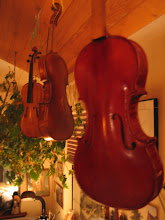I came across a paper in an academic journal, Physical Review Letters, which I found extremely interesting and would like to share with you. The title of the paper is called, "Spider silk violin strings with a unique packing structure generate a soft and profound timbre".
Abstract: We overcome the difficulties in pulling long draglines from spiders, twist bundles of dragline filaments and succeed in preparing violin strings. The twisting is found to change the cross section shapes of filaments from circular to polygonal, and to optimize the packing structure with no openings among filaments providing mechanically strong and elastic strings. The spider string signal peaks of overtones for the violin is relatively large at high frequencies, generating a soft and profound timbre. Such a preferable timbre is considered to be due to the unique polygonal packing structure which provides valuable knowledge for developing new type of materials.
Here is what the BBC wrote about Dr. Shigeyoshi Osaki's findings:
A Japanese researcher has used thousands of strands of spider silk to spin a set of violin strings.
The strings are said to have a "soft and profound timbre" relative to traditional gut or steel strings.
That may arise from the way the strings are twisted, resulting in a "packing structure" that leaves practically no space between any of the strands.
The strings will be described in a forthcoming edition of the journal Physical Review Letters.
Shigeyoshi Osaki of Japan's Nara Medical University has been interested in the mechanical properties of spider silk for a number of years.
In particular, he has studied the "dragline" silk that spiders dangle from, quantifying its strength in a 2007 paper in Polymer Journal.
Dr Osaki has perfected methods of obtaining large quantities of this dragline silk from captive-bred spiders and has now turned his attention to the applications of the remarkable material.
"Bowed string instruments such as the violin have been the subject of many scientific studies," he writes.
"However, not all of the details have been clarified, as most players have been interested in the violin body rather than the properties of the bow or strings."
Dr Osaki used 300 female Nephila maculata spiders - one of the species of "golden orb-weavers" renowned for their complex webs - to provide the dragline silk.
For each string, Dr Osaki twisted between 3,000 and 5,000 individual strands of silk in one direction to form a bundle. The strings were then prepared from three of these bundles twisted together in the opposite direction.
He then set about measuring their tensile strength - a critical factor for violinists wishing to avoid breaking a string in the midst of a concerto.
The spider-silk strings withstood less tension before breaking than a traditional but rarely used gut string, but more than an aluminium-coated, nylon-core string.
An electron microscope image shows a section of the bundle just 70 millionths of a metre wide A closer study using an electron microscope showed that, while the strings themselves were perfectly round, in cross-section the strands had been compressed into a range of different shapes that all fit snugly together, leaving no space between them.
Dr Osaki suggests that it is this feature of the strings that lends them their strength and, crucially, their unique tone.
"Several professional violinists reported that spider strings... generated a preferable timbre, being able to create a new music," he wrote.
"The violin strings are a novel practical use for spider silk as a kind of high value-added product, and offer a distinctive type of timbre for both violin players and music lovers worldwide."
The article contains a link to a recording of how spider silk strings sound: http://www.bbc.co.uk/news/science-environment-17232058
Saturday, March 10, 2012
Monday, February 27, 2012
Door-to-Door Traveling Violin Saleswoman
Tuesday, February 21, 2012
Thursday, January 26, 2012
Video About My Violin Building
Here is a video on me and my violin building by Hughes Hall. Enjoy!
Chasha Mindlin - Luthier from Hughes Hall on Vimeo.
Subscribe to:
Comments (Atom)



